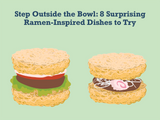
Amongst Japanese noodle enthusiasts, a common topic of debate is:
Ramen or Udon?
Today, let’s talk about the differences between ramen and other Asian noodles!
1. Ramen has a thicker, richer, and a more complex flavour profile than udon.
2. It also has more flavour variations like miso, shio, tonkotsu, and soy sauce. You just can’t get bored of eating ramen, even if you had a bowl everyday!
3. The Japanese like to have ramen as a late-night snack after a night of drinking.
4. There are so many more topping variations for ramen.
5. Udon and ramen noodles are both made of flour. However, the difference is that ramen noodles are a little bit yellow in color and stretchy because you mix kansui (alkaline solution) with the flour when you are making the ramen noodles.
Why udon is great...
1. Unlike ramen, udon is not oily, so it is better for your stomach and overall health.
2. Some people prefer udon's simple taste over the ramen’s strong flavour.
3. You can enjoy the chewiness of the noodles since udon is much thicker.
4. Udon goes well with nabe (or hot pot) in the cold winter.
5. Udon is versatile and is tasty with both cold soup or warm soup, making it perfect for all seasons.

Udon has variations too like Kanto style (bonito broth), Kansai style (Konbu broth), and Sanuki style (Iriko broth), but the variations are not as nearly as many as the ones available for ramen.
In North America, the two most popular Asian noodles are Japanese ramen and Vietnamese pho.
What makes these two Asian noodles so irresistible to North Americans? Let's take a closer look at the differences between the two and the ingredients that goes into making them:
For the Noodles:
Pho: Rice flour and waterRamen: Wheat flour and kansui (lye water)
For the Broth:
Pho: Beef bones or chicken bones, coriander, onions, ginger, aromatic spices. Flavour tends to be lighter and fresher.Ramen: Pork bones or chicken bones, anchovies, dried bonito, or vegetables. Flavor is thicker and stronger.
For the Sauce: (or other flavor enhancers)
Pho: Lime, fish sauce, chili sauceRamen: Shoyu (soy sauce), miso, shio (salt), or tonkotsu (simmered pork bone)
For the Toppings:
Pho: Slices of pork, beef, chicken, fresh herbs and vegetables
Ramen: Chashu (braised pork), boiled egg, seaweed, green onion

For a bowl of pho, simplicity is the best. if you can make good use of the basic ingredients, your pho becomes exceptional. People who like pho over ramen like it for its simplicity.
The soup is transparent and has umami, but it is not heavy and greasy. All the ingredients should be fresh-picked and the ingredients combine well with each other. Balance is the most important for pho.
In contrast to the pho broth’s light and fresh taste, ramen soup is more complex, greasy, and thick. People who like ramen over pho like this richness and complex flavour.
In Japan, some chefs will close down their store for the day if they aren't 100% satisfied with the flavor of their broth. This is because the soup is a very important element of the dish and will alter the overall taste of the ramen. It takes long hours to make a bowl of perfect broth. The next most important element of ramen is the noodles. The balance of the noodles' chewiness is the part that chefs pay close attention to as soggy or hard noodles ruin the ramen.
We've compared ramen with some other different noodle counterparts like udon and pho, but what about different types of ramen?
Have you ever wondered, what is the difference between ramen from restaurants and instant ramen?


Let me ask you a question.
Which of these following statements are TRUE?
A. Kansui (lye water or alkaline solution) is used in both ramen and instant ramen.
B. All instant ramen are fried in order to keep them preservable.
C. Instant noodles have the most calories in comparison to half a bag of potato chips and meat sauce spaghetti.

The correct answer is...
A

A lot of people think ramen and instant ramen are very different, but in reality, they’re not really that different!
The noodles in both consist of wheat flour and kansui.
Kansui adds some flavour into the noodles and this flavour goes well with the ramen soup.
Here is the process of making ramen or instant noodles:
1. Mix kansui and flour together.
2. Make the dough flat.
3. Cut into thin noodles.
4. Divide into one-meal portions.
-------Additional process for instant ramen-------
5. Steam the noodles.
6. Dry the noodles.
7. Cool down the noodles.
8. Pack the noodles into cups or bags.
So why is Statement B incorrect?
Instant ramen are not ALL fried in order to keep them preservable, others are actually blow-dried with hot air.
As we all know, instant ramen have a very long shelf life. When we open up a bag or a cup of instant ramen, we see a block of super dehydrated and compacted noodles inside. How do they get dehydrated for the packing process? 
There are actually two kinds of drying-process for instant noodles:
1. One is frying the noodles. After steaming the noodles, workers fry noodles in 300F oil for 2-3 minutes. This method can drastically decrease the water content from 30% to a few percent.
2. The other way is placing in a drying machine which blows hot wind (approx. 180F) for over 30 minutes.
So why is Statement C also incorrect?
Instant noodles have the least calories in comparison to half a bag of potato chips and meat sauce spaghetti.

Potato chips (half bag or 4oz bag) : 608 calories

Meat sauce spaghetti : 329 calories

Instant noodles : 280 calories
This actually makes instant ramen the lowest calorie snack out of the three!
Ramen at a restaurant gives us an amazing dining experience and takes us on a journey of rich variety with the many broths and toppings we can select from.
Instant noodles are a quick and convenient lazy lunch when we’re hungry and don’t have time to cook.
At home, what is your go-to recipe?
Whether you're a fan of the ramen's intense and flavorful soup, the chewiness of udon noodles, pho broth's clear and fresh taste, or quick and easy instant ramen, our large ceramic and melamine bowls' generous capacity can hold everything without fear of spillage!
Come take a look at some of our favorite bowls!
11 Crucial Differences Everyone Should Know: Ramen vs. Pasta




Leave a comment